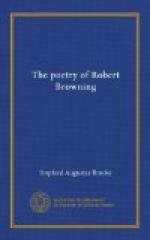Well, here’s the platform,
here’s the proper place:
Hail to your purlieus,
All ye high-flyers of the
feathered race,
Swallows and curlews!
Here’s the top-peak;
the multitude below
Live, for they
can, there:
This man decided not to Live
but Know—
Bury this man
there?
Here—here’s
his place, where meteors shoot, clouds form,
Lightenings are
loosened.
Stars come and go! Let
joy break with the storm,
Peace let the
dew send!
Lofty designs must close in
like effects:
Loftily lying,
Leave him—still
loftier than the world suspects,
Living and dying.
This is the artist at work, and I doubt whether all the laborious prose written, in history and criticism, on the revival of learning, will ever express better than this short poem the inexhaustible thirst of the Renaissance in its pursuit of knowledge, or the enthusiasm of the pupils of a New Scholar for his desperate strife to know in a short life the very centre of the Universe.
Another poem on the arts which is mixed up with Browning’s theory of life is Andrea del Sarto. Into it the theory slips, like an uninvited guest into a dinner-party of whom it is felt that he has some relation to some one of the guests, but for whom no cover is laid. The faulty and broken life of Andrea, in its contrast with his flawless drawing, has been a favourite subject with poets. Alfred de Musset and others have dramatised it, and it seems strange that none of our soul-wrecking and vivisecting novelists have taken it up for their amusement. Browning has not left out a single point of the subject. The only criticism I should make of this admirable poem is that, when we come to the end, we dislike the woman and despise the man more than we pity either of them; and in tragic art-work of a fine quality, pity for human nature with a far-off tenderness in it should remain as the most lasting impression. All the greater artists, even while they went to the bottom of sorrow and wickedness, have done this wise and beautiful thing, and Browning rarely omits it.
The first art-matter in the poem is Browning’s sketch of the sudden genesis of a picture. Andrea is sitting with his wife on the window-seat looking out to Fiesole. As he talks she smiles a weary, lovely, autumn smile, and, born in that instant and of her smile, he sees his picture, knows its atmosphere, realises its tone of colour, feels its prevailing sentiment. How he will execute it is another question, and depends on other things; but no better sketch could be given of the sudden spiritual fashion in which great pictures are generated. Here are the lines, and they also strike the keynote of Andrea’s soul—that to which his life has brought him.




